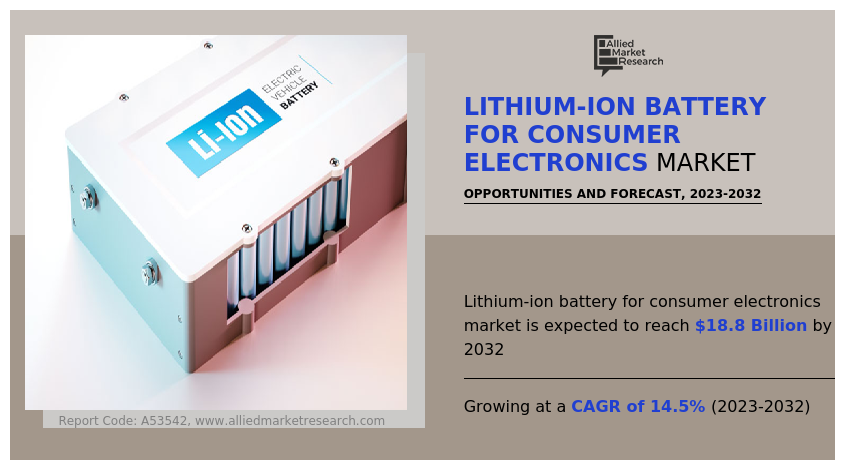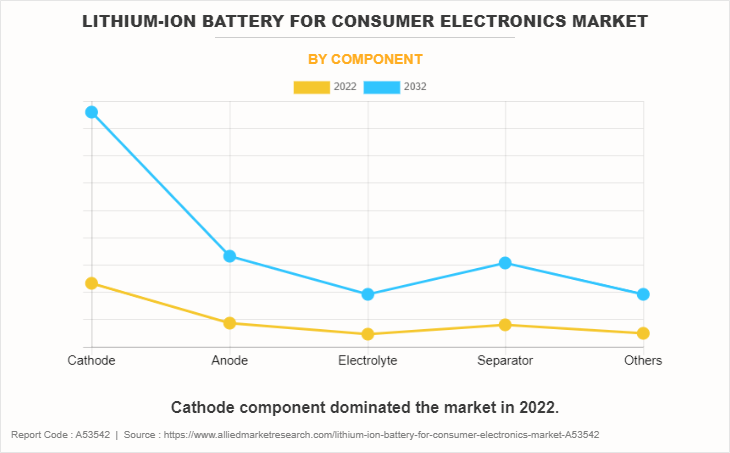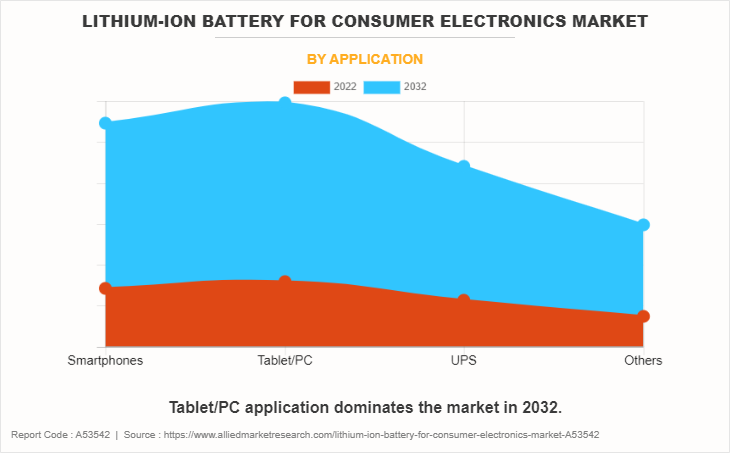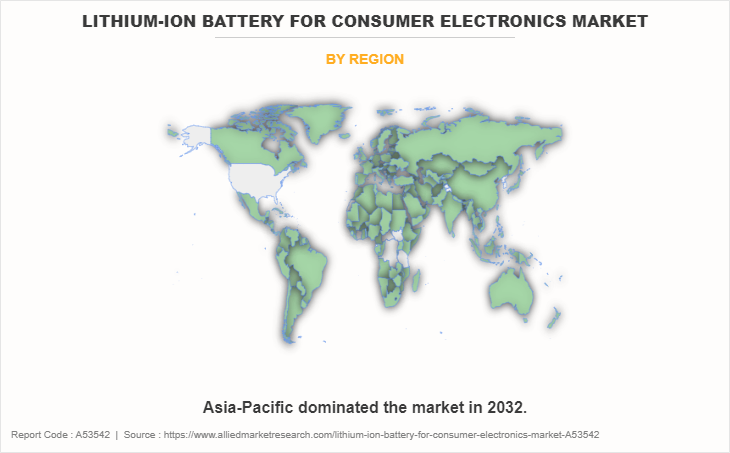Lithium-ion Battery For Consumer Electronics Market Research, 2032
The global lithium-ion battery for consumer electronics market was valued at $4.9 billion in 2022, and is projected to reach $18.8 billion by 2032, growing at a CAGR of 14.5% from 2023 to 2032.

A lithium-ion battery is a rechargeable energy storage device that utilizes lithium ions moving between the positive and negative electrodes to store and release electrical energy. It is a type of rechargeable battery that has gained widespread use in various applications, including portable electronics and renewable energy systems. The increase in future applications of lithium-ion batteries in consumer electronics and renewable energy storage has paved the way for significant advancements in energy storage technology. The demand for efficient and reliable power sources has increased due to the rapid innovation and development of these sectors.
The portable electronic industry has witnessed a surge in the adoption of portable consumer electronics driven by surge in demand for smartphones and wearables. The increase in population and rise in awareness regarding the utilization of portable electronics in daily life have led to the demand for consumer electronics, which has increased the demand for lithium-ion batteries as they are a key component in consumer electronics appliances. In addition, the widespread use of consumer electronics in everyday life has created a significant need for high-performance rechargeable batteries. Lithium-ion batteries have found application in a wide range of devices, including smartphones, laptops, tablets, and wearable technology. The continuous advancements in these electronic devices, along with increase in consumer expectations for longer battery life and faster charging have further propelled the demand for lithium-ion batteries.
Furthermore, the expansion of renewable energy sources such as residential solar and micro wind power has necessitated efficient energy storage solutions. Lithium-ion batteries play a crucial role in storing energy generated from these sources, enabling stability, and facilitating the integration of renewable energy into existing power systems. The growth in emphasis on sustainability and the transition toward clean energy sources have created significant opportunities for lithium-ion battery in the field of renewable energy storage and consumer electronics.
However, the production of lithium-ion batteries faces several challenges. One of the key issues is the concern over the environmental impact associated with the extraction and disposal of lithium, as well as the manufacturing process itself. Efforts are being made by manufacturers to develop more sustainable and environmentally friendly battery production methods to address the abovementioned concerns.
Moreover, safety concerns related to lithium-ion batteries, such as the risk of thermal runaway and potential fire hazards, require continuous R&D to improve battery design and implement robust safety mechanisms. The industry is focused on enhancing battery performance, extending cycle life, and increasing energy density while ensuring safety and reliability.
“The Future of Lithium-Ion Batteries: Powering the portable electronic gadgets”
Lithium-ion batteries are set to shape the future of portable electronic gadgets with their continued advancements and potential applications. Key developments in the field include increased energy density, fast charging capabilities, extended cycle life, and the emergence of solid-state batteries. These improvements are anticipated to pave the way for a more sustainable and efficient energy landscape.
Manufacturers have made efforts to enhance energy density in lithium-ion batteries and are focused on storing more energy in smaller and lighter packages. This advancement is anticipated to enable longer-lasting devices and increase the battery life of the electronic gadget. In addition, researchers work on reducing charging times by exploring advanced battery chemistries and charging infrastructure improvements.
Battery durability is another area of focus, aiming to extend the number of charge-discharge cycles a battery is expected to withstand. This is anticipated to reduce the need for frequent replacements and contribute to a more sustainable battery lifecycle. Solid-state batteries, which use a solid electrolyte instead of a liquid one, offer improved safety, higher energy density, and enhanced thermal stability. They represent a promising avenue for future energy storage technologies.
Sustainability is a driving force behind future lithium-ion batteries. Manufacturers develop greener production processes, minimizing the environmental impact of battery manufacturing. In addition, advancements in battery recycling technologies are expected to enable the recovery of valuable materials and contribute to a circular economy. The future of lithium-ion batteries for consumer electronics looks promising as they continue to evolve and power various portable electronic devices. These advancements are anticipated to play a pivotal role in achieving a greener and more sustainable future by decarbonizing transportation, supporting renewable energy integration, and driving the demand for lithium-ion batteries.
The lithium-ion battery for consumer electronics market is segmented on the basis of component, application, and region. On the basis of component, the lithium-ion battery for consumer electronics market is classified into cathode, anode, electrolyte, separator, and others. By application, it is divided into smartphone, tablet/PC, UPS, and others. Region wise, it is analyzed across North America, Europe, Asia-Pacific, and LAMEA.

Based on component, the cathode segment held the highest market share in 2022, accounting for nearly half of the global lithium-ion battery for consumer electronics market revenue, and is estimated to maintain its leadership status throughout the lithium-ion battery for consumer electronics market forecast period. The rapid expansion of consumer electronics and other electronic devices across various domains has led to an increase in the demand for lithium-ion batteries. The presence of the demand for battery has a significant positive impact on the lithium-ion battery for consumer electronics market.

Based on application, the tablet/pc segment held the highest market share in 2022, accounting for nearly one-third of the global lithium-ion battery for consumer electronics market revenue, and is estimated to maintain its leadership status throughout the forecast period. the rapid expansion of consumer electronics sectors, which includes the demand for smart electronic gadgets and increase in the IT sector related industries in Asia-Pacific region will have positive impact on the market.

Based on region, Asia-Pacific held the highest lithium-ion battery for consumer electronics market share in terms of revenue in 2022, accounting for more than two-fifths of the global lithium-ion battery for consumer electronics market revenue, and is likely to dominate the market during the forecast period. Furthermore, the Asia-Pacific region is expected to witness the fastest CAGR of 15% from 2023 to 2032. The Asia-Pacific region presents significant growth potential in the lithium-ion battery market. Emerging markets, such as India, China, and Southeast Asian countries, have witnessed rapid industrial growth which will lead to increased demand for lithium-ion battery for consumer electronics market.
Key players engaged in the development and production of Lithium-ion battery for consumer electronics products are CATL, Lithium Werks, EVE Energy Co., Ltd, Johnson Controls, Panasonic, LG Chem, Samsung SDI, Toshiba, Lishen Battery, and Hitachi. The abovementioned companies' unique services and innovative approaches contribute to the advancement of the Lithium-ion battery for consumer electronics market, enabling more efficient, sustainable, and environmentally friendly practices for corporates to move toward sustainability.
Key Benefits For Stakeholders
- This report provides a quantitative analysis of the lithium-ion battery for consumer electronics market size, segments, current trends, estimations, and dynamics of the lithium-ion battery for consumer electronics market analysis from 2022 to 2032 to identify the prevailing lithium-ion battery for consumer electronics market opportunities.
- The market research is offered along with information related to key drivers, restraints, and opportunities.
- Porter's five forces analysis highlights the potency of buyers and suppliers to enable stakeholders make profit-oriented business decisions and strengthen their supplier-buyer network.
- In-depth analysis of the lithium-ion battery for consumer electronics market segmentation assists to determine the prevailing market opportunities.
- Major countries in each region are mapped according to their revenue contribution to the global market.
- Market player positioning facilitates benchmarking and provides a clear understanding of the present position of the market players.
- The report includes the analysis of the regional as well as global lithium-ion battery for consumer electronics market trends, key players, market segments, application areas, and lithium-ion battery for consumer electronics market growth strategies.
Lithium-ion Battery for Consumer Electronics Market Report Highlights
| Aspects | Details |
| Market Size By 2032 | USD 18.8 billion |
| Growth Rate | CAGR of 14.5% |
| Forecast period | 2022 - 2032 |
| Report Pages | 388 |
| By Component |
|
| By Application |
|
| By Region |
|
| Key Market Players | LG Chem, EVE Energy Co., Ltd, Lithium Werks, Hitachi, Ltd., Lishen Battery, Toshiba Corporation, Johnson Controls International plc, Samsung SDI Co., Ltd, Contemporary Amperex Technology Co., Limited, Panasonic Corporation |
Analyst Review
According to CXOs perspective, lithium-ion batteries are expected to experience significant growth in demand due to the increase in awareness among individuals and businesses regarding the advantages of energy storage and the efficient use of lithium-ion battery technology. Lithium-ion batteries are preferred over other battery technologies due to their high energy density, longer lifespan, and faster charging capabilities.
The CXOs further added that the lithium-ion battery for consumer electronics market is poised for rapid expansion during the forecast period, driven by the growth in the need for reliable energy storage solutions in renewable energy systems and the demand for portable consumer electronics. Governments across the globe promote the transition to clean energy and support the deployment of energy storage technologies through various incentives and regulations. This has led to an upsurge in demand for lithium-ion batteries in residential applications.
In Asia-Pacific, the lithium-ion battery for consumer electronics market presents lucrative opportunities for key manufacturers due to the increase in population and adoption of IoT in their lifestyle for comfort. Countries such as China, Japan, and South Korea are leading in the adoption of renewable energy sources such as residential solar, thereby driving the demand for lithium-ion batteries.
The surge in demand for energy storage solutions in the consumer sector, especially during peak usage periods, serves as a significant driver for the global lithium-ion battery for the consumer electronics market. Major market players actively respond to this demand through investment in R&D to improve battery performance, enhance safety features, and reduce costs. Moreover, the increase in demand for portable electronic gadgets due to the rise in the application of IoT is expected to further boost the demand for lithium-ion batteries.
However, despite the positive outlook, there are challenges that need to be addressed for the widespread adoption of lithium-ion batteries. The concerns regarding the environmental impact of lithium-ion battery production, disposal, and safety concerns related to the lithium-ion battery need to be carefully managed to ensure sustainable growth in the market.
Fast charging technology, solid-state batteries, integration with IoT devices, collaboration and partnerships are the upcoming trends of Lithium-ion Battery for Consumer Electronics Market in the world.
Tablet/PC is the leading application of Lithium-ion Battery for Consumer Electronics Market.
Asia-Pacific is the largest regional market for Lithium-ion Battery for Consumer Electronics.
$18.8 Billion is the estimated industry size of Lithium-ion Battery for Consumer Electronics.
Samsung, LG Chem, Toshiba Corporation, and CATL are the top companies to hold the market share in Lithium-ion Battery for Consumer Electronics.
Loading Table Of Content...
Loading Research Methodology...



